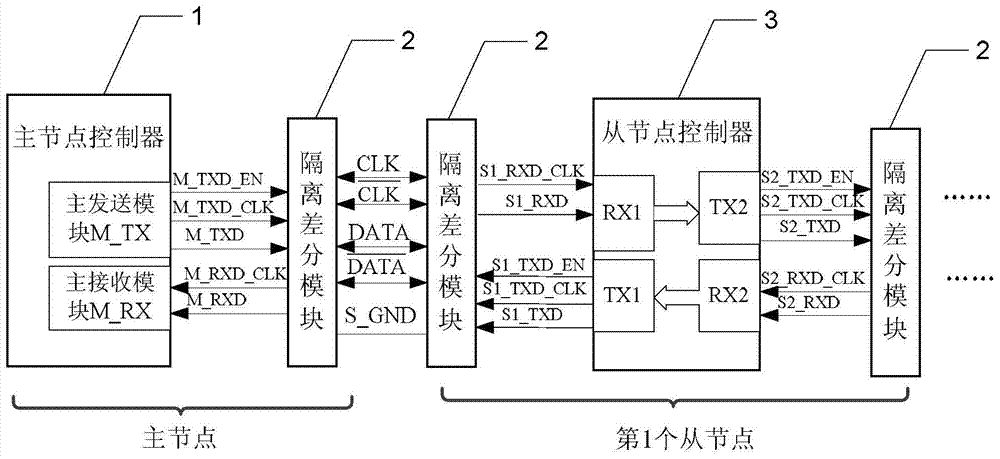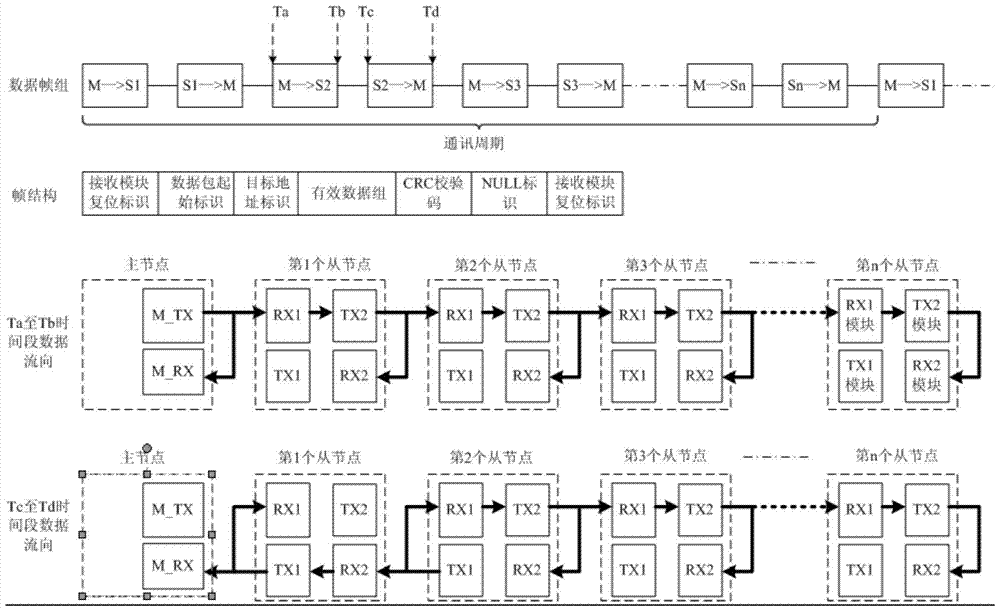Master-slave synchronous serial communication bus based on node cascading and its realization method
A technology of synchronous serialization and implementation method, which is applied in the fields of instruments, electrical digital data processing, etc., can solve the problems of limited number of nodes, communication distance and speed, and achieve the extension of network communication distance and anti-interference ability, guaranteeing the timing relationship, The effect of improving the communication distance
- Summary
- Abstract
- Description
- Claims
- Application Information
AI Technical Summary
Problems solved by technology
Method used
Image
Examples
specific Embodiment approach 1
[0028] Specific implementation mode one: the following combination figure 1 Describe this embodiment, the master-slave synchronous serial communication device based on node cascading described in this embodiment, the communication device includes a master node and n slave nodes, n is a positive integer, and the master node includes a master node controller 1 and an isolated Differential module 2, the master node controller 1 includes a master transmitting module M_TX and a master receiving module M_RX, each slave node includes a slave node controller 3 and two isolated differential modules 2, and the slave node controller 3 includes a first slave receiving module RX1 , the second slave receiving module RX2, the first slave sending module TX1 and the second slave sending module TX2;
[0029] The main transmission module M_TX and the isolated differential module 2 of the master node are connected through the enable signal line M_TXD_EN, the clock signal line M_TXD_CLK and the da...
specific Embodiment approach 2
[0036] Specific implementation mode two: the following combination figure 2 Describe this embodiment, this embodiment will further explain the first embodiment, in the slave node controller 3, the first slave receiving module RX1 and the second slave transmitting module TX2 pass the differential bus state identification signal line IDLEFlag, and the back-end slave node receives the identification The signal line BackFlag, the master node receiving identification signal line S2MFlag, the clock signal line CLK1 and the data signal line DATA1 are connected; the second slave receiving module RX2 and the first slave sending module TX1 pass the address matching identification signal line EqualFlag and the enabling identification signal line EnableFlag, the clock signal line CLK2 and the data signal line DATA2 are connected; the first slave receiving module RX1 assigns the signals on the clock signal line S1_RXD_CLK and the data signal line S1_RXD to the clock signal line CLK1 and th...
specific Embodiment approach 3
[0037] Specific implementation mode three: the following combination Figure 3-Figure 5 Describe this implementation mode, the implementation method of the master-slave synchronous serial communication device based on node cascading described in this implementation mode, the specific process of this implementation method is:
[0038] The master node controller 1 periodically reads the valid data received by the main receiving module M_RX, and then sends the valid data group and control instructions to be sent to the main sending module M_TX, and assigns the sending end flag to the sending start Start the main transmission module M_TX by means of the identification bit. After the main transmission module M_TX is started, the valid data is assembled into multiple data frames, and the clock signal is sent to each node in time-sharing serially through the differential bus;
[0039] Master node controller 1 reads the dual-port memory RAM according to the system clock through the ad...
PUM
 Login to View More
Login to View More Abstract
Description
Claims
Application Information
 Login to View More
Login to View More - R&D
- Intellectual Property
- Life Sciences
- Materials
- Tech Scout
- Unparalleled Data Quality
- Higher Quality Content
- 60% Fewer Hallucinations
Browse by: Latest US Patents, China's latest patents, Technical Efficacy Thesaurus, Application Domain, Technology Topic, Popular Technical Reports.
© 2025 PatSnap. All rights reserved.Legal|Privacy policy|Modern Slavery Act Transparency Statement|Sitemap|About US| Contact US: help@patsnap.com



